2023.08.04.86
Files > Volume 8 > Vol 8 no 4 2023
The performance of moringa leaf extract application and bagging the bunches to improve fruits quality of date palm (Phoenix dactylifera L.) cv. Al-Khadrawi and Al-Buraim
MohammedAbdulrahman1, ManarAlwan2, KadumAbdullah2*, MariamChaffat3
1 Horticulture
and Landscape Department/ College of Agriculture/ University of Kerbala/
Karbala, Iraq; [email protected]. https://orcid.org/0000-0001-6675-8189
2
2 Department
Horticulture and Landscape/ College of Agriculture Al-Qasim Green University; [email protected].
2 Horticulture
and Landscape Department/ College of Agriculture/ University of Kerbala,
Karbala/ Iraq;
https://orcid.org/0000-0002-9619-5900
3 Plant
Protection Department, College of Agriculture, University of Kerbala, Karbala,
Iraq.
* Correspondence:
[email protected].; Tel.: 0771 723 8168
Available
from. http://dx.doi.org/10.21931/RB/2023.08.04.86
ABSTRACT
The study was conducted at the Fadak farm
of the Husseiniya shrine/ Karbala governorate during the growth season 2021 to
test the role of application with Moringa leaf extract and the paper bagging of
the bunches in improving some qualitative
characteristics of the fruits of two palm cultivars, Al-Khadrawi
and Al-Buraim. The bunches were sprayed with three concentrations of
moringa leaf extract (0, 100, 200 ml. L-1)
three times after 7, 10, and 13 weeks of pollination and then bagging the
bunches after each application process according to the schedule and plan of
the experiment. The results indicated that application with moringa extract and
bagging increased the proportion of total dissolved solids (T.S.S.), total
sugars and reducing sugars, and decreased the total acidity neutralizing,
sucrose, and tannins. Al-Khadrawi cultivar was superior in most of the studied
traits.
The study’s findings suggest that natural
plant extracts (such as Moringa leaf extract) can be utilized as organic
amendments or fertilizer additives in conjunction with particular farming
practices to enhance the quality of the fruits of some varieties of date palms.
Keywords: T.S.S.; natural extract; Phoenix
dactylifera; Arecaceae; Moringaoleifera.
INTRODUCTION
The palm
tree species Phoenix dactylifera L. is a member of the Arecaceae family
of palms. The number of their species worldwide is estimated at 1500 species1. About 600 of them are registered in Iraq2,
which is one of the oldest palm plantations in the world. Therefore, it is
believed that Iraq and the Arab Gulf region are its original home. The fruit of
the date palm has much potential. Its fruits, seeds, pits, and byproducts all
contain the potential for both nourishment and medicine because fruits and
seeds are packed in nutrients such phenolics, dietary fibers, vitamins,
minerals, and amino acids which makes them have many functions such as
antibacterial, antioxidant, anticancer, and antidiabetic properties and the
presence of phytochemicals such as carotenoids, phenolic acid, flavonoids,
tocopherol, phytosterols, etc. boosts these bioactivities 3.
The al-Khadrawi variety is one of the commercial varieties characterized
by slight greenness in its fruits. Its cultivation spreads in the central and
southern regions of Iraq. It has several names, including Khadrawi Basra and
Khadrawi Mandali. Its fruits are consumed in the wet stage and have a
distinctive flavour4. Al-Buraim is one of the most important dates
in Basra. Its cultivation spreads throughout Iraq, and its ripe fruits are of
excellent quality and eaten in the Khalaal and Rutab stages. It is eaten as
cooked Khalaal and is not left most of the time until the Tamr stage 5.
In recent
years, global interest in the quality of food consumed has increased, so many
practices have emerged that improve the quality of fruits without leaving
adverse effects on human health and the environment. One of these practices is
using plant extracts that can serve the same purpose as industrial materials
but without any danger to humans and the environment 6. Due to their
abundant quantity of different active ingredients, plants serve as the primary
source of raw substances for the synthesis of essential and practical
bio-products (such as food, cosmetics, medications, bio-stimulants,
bio-pesticides, and feed) such that many plant components, including seeds,
fruits, flowers, stems, leaves, and roots, have been utilized in their
productio7. The stimulating properties of botanical extracts are
attributed to organic compounds, including polyphenols, amino acids, plant
hormones, and vitamins, as well as both micro- and macro-elements; however,
their impact on enhancing the quantity and quality of crops depends on the crop
species, cultivar, stage of growth, environmental conditions, as well as dose,
timing, and application method 8,9 Among these extracts is Moringa oleifera leaf extract as a natural alternative
because it contains many growth hormones, especially zeatin, which is derived
from the plant cytokinin group, antioxidants, nutrients and vitamins10and thus its effect is similar for the effect of
synthetic growth regulators 11. In a study conducted in Egypt by 12application
the bunches of the palm cultivar Al-Khadrawi with
Moringa leaf extract at a concentration of 3% three times between one spray and
another month, where the first spray was three hours before pollination, it was
found that the application treatment significantly outperformed the proportion
of total soluble solids accumulated in the fruit and total sugars as well as
reducing sugars. In contrast, application with the extract reduced the
non-reducing sugars. As for the neutralizing total acidity, there are no
significant differences between the spray and comparison treatment and the case
for total tannins in the fruit.
The process
of muzzling, i.e., bagging the bunches with different covers, is an essential
physical process, especially in hot and dry areas, as it improves the quality
of the fruits and protects them from some insect pests, mechanical damage and
unsuitable climatic factors that negatively affect the quality and productivity
of the palm fruits 13. Al-Issawi14 found that when bagging
the Khastawi cultivar with different types of covers (transparent polyethylene,
black polyethylene, unique sleeve bags, mesh cloth, and paper bags), all covers
increased the quality of the fruits.
In order to
improve the quality of the fruits and highlight the importance of using natural
extracts and specific agricultural techniques to produce high-quality
horticultural crops, the study evaluated the effectiveness of applying Moringa
leaf extract on bunches and bagging them with
paper. It also examined how these two practices interacted with various
cultivars of palm trees (Al-Khadrawi Basra and Al-Buraim).
The field
experiment was launched at the Fadak farm of the Husseiniya shrine during the
season 2021. Thirty-six palm trees were selected, with eighteen palm trees for
each cultivar at the age of five years, homogeneous in size and growth strength
as much as possible. Manual pollination and thinning were carried out by
leaving 6 bunches. Palm-1. Three elements were examined in the study.
The first element was three different concentrations of moringa leaf
extract(200,100.0 ml. L-1) applied on the bunches with three sprays.
The first spray was after 7 weeks of pollination (the end of the Hababuk stage
and the beginning of the Jamri stage), and between one spray and another was 21
days. The second factor was using bagging with closed-end perforated paper
bags, where the bagging process was done immediately after the first spray and
the bags were lifted at the third spray. The third factor included two
cultivars: Al-Khadrawi Basra and Al-Buraim. The
experiment was designed in a Randomized Complete Block design, R.C.B.D., with
three replications, and the averages were compared according to Duncan’s
polynomial test at a probability level of 0.05 15. The qualitative
characteristics of the fruits were measured, where the proportion of dry mass
and water content (%), the proportion of total soluble solids (T.S.S.) (%),
which were measured using Hand Refractometer according to 16, total and reducing sugars and sucrose (%) which were
estimated using The Lane and Eynon method mentioned by 17, the total
neutralizable acidity (%) determined as in 18 and the proportion of
tannins (%) calculated by the method of 19.
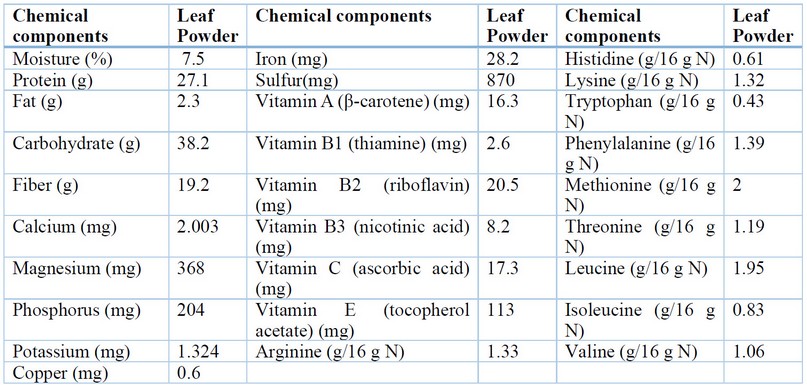
Table 1.
Chemical analytical assessment of 100 g of powdered Moringa oleifera leaves.
Water content of fruits (%)
It is noticed from Table 2 that application
with moringa leaf extract reduced the water content of the fruits, as the most
significant proportion was observed with the comparative treatment of 29.36 %, while
the lowest proportion was detected at a concentration of 200 ml. L-1
of 25.69%, while the bagging increased the water content of the fruits, as the bagging
treatment reached 28.57%, while treatment without bagging gave 26.23%. The two
cultivars also differed in the water content in their fruits, where the fruits
of the Al-Khadrawi cultivar recorded the most significant proportion of 31.33%.
At the same time, the proportion in Al-Khadrawi variety was 23.56%. Regarding
the relationship between extract application and bagging, the application
treatment at a concentration of 0 ml. L-1 with bagging recorded the most
significant proportion, 30.71%, while the concentration was 200 ml. L-1
recorded the lowest proportion, which was 24.40% without paper cover.
On the other hand, the comparison
treatment of moringa extract on the Al-Khadrawi cultivar outperformed by giving
the most significant proportion, reaching 34.21%, while the application dose of
200 ml. L-1 on the Al-Buraim cultivar recorded the lowest water
content proportion, 22.98%. Regarding the interaction between bagging and
cultivar, Al-Khadrawi’s bagging treatment outperformed Al-Buraim’s non-bagging
treatment by recording a proportion of fruit water content that reached 32.12%.
In contrast, Al-Buraim’s non-bagging treatment recorded the lowest proportion,
22.11%.
The interaction of the three examined
variables significantly impacted the water content of the fruits, as it was
noted that the spray application was at a concentration of 0 ml. L-1
with bagging on Al-Khadrawi cultivar gave the most significant proportion of
35.20%, while application with a concentration of 200 ml. L-1
without bagging on the Al-Buraim cultivar recorded the lowest proportion of
21.43% Table 2.
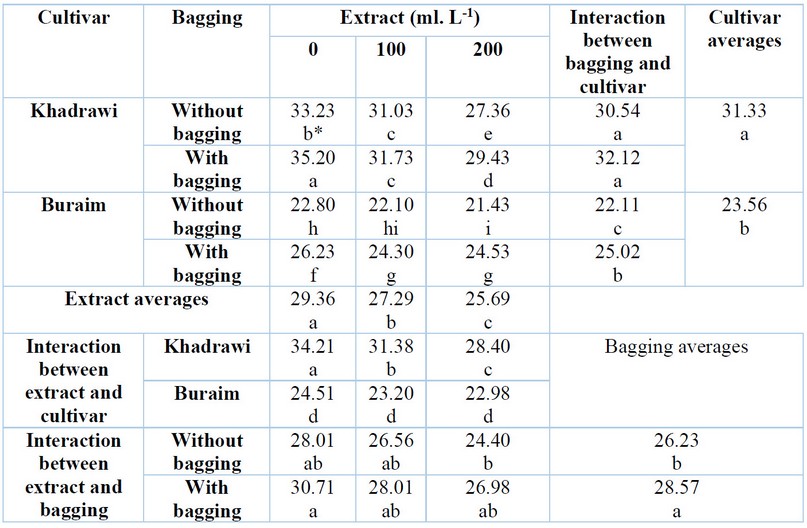
* Means that share the same letters do not differ
significantly among themselves according to Duncan’s polynomial test at the
0.05 probability level.
Table 2. Impact of applying moringa leaf extract, bagging the
bunches, and their interactions on the water content of the (%) of two palm
cultivars.
Fruit dry matter proportion (%)
The data
in Table 3 indicated that the proportion of dry matter of the fruits gradually
increased with the increase in the concentration of moringa leaf extract, where
the spray application was at a concentration of 200 ml. L-1 had the
most significant proportion of 74.30%. The comparison sprays recorded a
proportion of 70.63%, while bagging reduced the dry matter in the fruits,
reaching 73.76% in the treatment without bagging. In comparison, it amounted to
71.42% in the bagging treatment. As for the cultivars, it is noticeable that
there are significant differences between them, as the Al-Buraim cultivar has a
significant score of 76.43%, superior to the Al-Khadrawi cultivar, which has a
rate of 68.66%—the spray application with 200 ml. L-1 and without
bagging was superior to 75.60%, while the 0 ml. L-1 treatment with
bagging was the lowest, which amounted to 69.28%—also, the application
treatment with a concentration of 200 ml. L-1 was superior to the
Al-Buraim cultivar, with the most significant proportion of 77.01%.
The
comparison treatment for the Al-Khadrawi cultivar recorded a smaller proportion
of 65.78%. In comparison, the non-bagging treatment of the Al-Buraim cultivar
outperformed because it gave the most significant proportion of 77.88%, while
the lowest proportion was in the bagging treatment for the fruits of the
Al-Khadrawi cultivar, which amounted to 67.87%. The data of the triple
interaction indicated that the application treatment with 200 ml. L-1
without bagging the Al-Buraim cultivar recorded the most significant proportion
of dry matter in the fruits, amounting to 78.56%, during the application with 0
ml. L-1 with bagging on the fruits of the Al-Khadrawi variety
recorded the lowest rate of 64.80% Table 3.
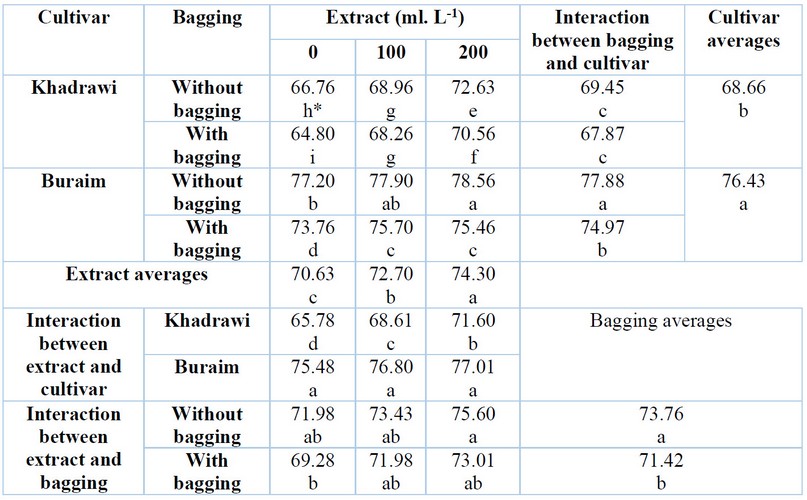
* Means that share the same letters do not differ significantly among
themselves according to Duncan’s polynomial test at the 0.05 probability level.
Table
3. Impact of applying moringa leaf extract, bagging the bunches, and their
interactions on fruit dry matter proportion (%) of two palm cultivars.
Total Soluble Solids (%) (T.S.S.)
Table 4 shows that the proportion of total soluble
substances increased with an increase in the application of moringa leaf
extract, where the application of 200 ml. L-1 gave the most
significant proportion of 57.23%, while the comparison treatment revealed the
lowest proportion of 51.80%. Also, the proportion of total soluble solids
increased with the bagging of the bunches was 55.55%, with a significant
difference from the treatment without packaging, which amounted to 53.77%.
Al-Khadrawi cultivar significantly outperformed the Al-Buraim cultivar, as
their proportions reached 55.86 and 53.46%, respectively.
There was
a remarkable effect of the dual interaction between the extract and the bagging, where the application was 200 ml. L-1
with the bagging was superior to all treatments, which was 57.46%. In contrast,
the comparison treatment recorded the lowest proportions, amounting to 51.00%,
and the treatment of application of Al-Khadrawi cultivar with Moringa leaf
extract with a concentration of 51.00%. 200 ml. L-1 with a ratio of
58.58%, while the comparison application for Al-Buraim gave less proportion,
which was 50.88% Table 4,.The process of bagging the fruits of the cultivars
had a considerable effect on T.S.S. The bagging of the Al-Khadrawi cultivar
excelled by producing the most significant proportion, which was 56.73%.
The
cultivar Al-Buraim gave the lowest rate of 52.55% without bagging. As for the
effect of the triple interactions of the study factors, it was significantly
superior to the spray of 200 ml. L-1 with bagging for the
Al-Khadrawi variety reached 59.83%, while the lowest proportion was in the
comparison treatment for the Al-Buraim variety, which was 50.00% (Table 4).
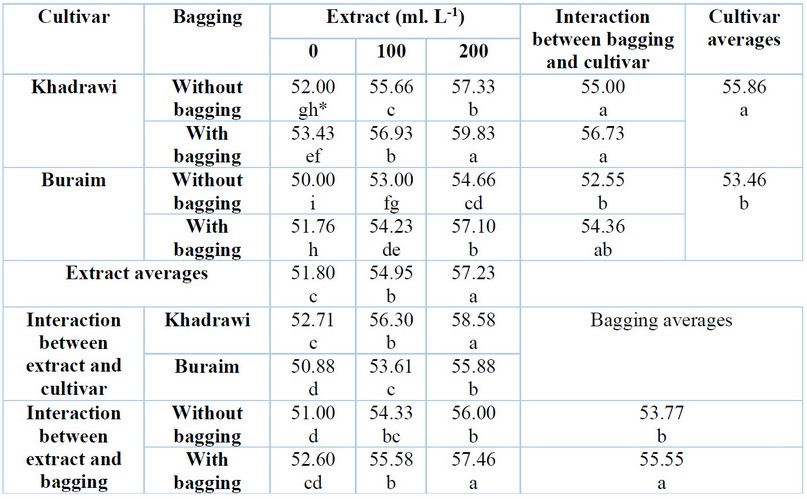
*
Means that share the same letters do not differ significantly among themselves
according to Duncan’s polynomial test at the 0.05 probability level.
Table 4. Impact of moringa leaf extract, bagging the bunches, and
their interactions on two palm cultivars’ total soluble solids (%) (T.S.S.).
Total sugars (%)
The data
of Table 5 indicates that application with moringa leaf extract increased the proportion
of total sugars in fruits, whereas the application with 200 ml. L-1
was significantly superior by giving it the most significant proportion of
51.76%, but the comparison application gave a lower proportion of 46.27%. The
bagging practice also increased the proportion of total sugars in the dates.
Hence, the proportion in the bagging treatment was 50.65%, with a significant
difference from the treatment without bagging, which recorded the lowest rate
of 47.75%. The fruits of the two cultivars also varied in terms of the
proportion of total sugars, with the Al-Khadrawi cultivar yielding the greatest
sugars ratio of 50.74 percent, significantly outperforming the Al-Buraim
cultivar, which provided just 47.66 percent.
The same
table also demonstrates that the application of the moringa extract and bagging
interacted significantly, showing the extract treatment’s superiority at a
concentration of 200 ml. L-1 with bagging, where the ratio reached
52.74%, while the comparative dose gave a rate of 44.63%. When applied to the
Al-Khadrawi cultivar, the two treatments were at 200- and 100 ml
concentrations. L-1 resulted in
Respective
proportions of 53.18% and 51.21%, whereas the comparative treatment for the
Al-Buraim cultivar yielded the lowest proportion of 44.70%. While the
comparison treatment for the Al-Buraim cultivar recorded the lowest proportion,
46.21%, the packing treatment for the Al-Khadrawi cultivar recorded the most
significant total sugar content, 52.19%.
Regarding
the triple interaction, Table 4’s findings show the two application treatments
with 200- and 100 ml concentrations. L-1 with the packaging of
Al-Khadrawi fruits was superior. These treatments had the most excellent rates,
reaching 53.94 and 52.73%, respectively, while the comparison treatment for the
Al-Buraim variety had the lowest rate, 43.49% Table 5.
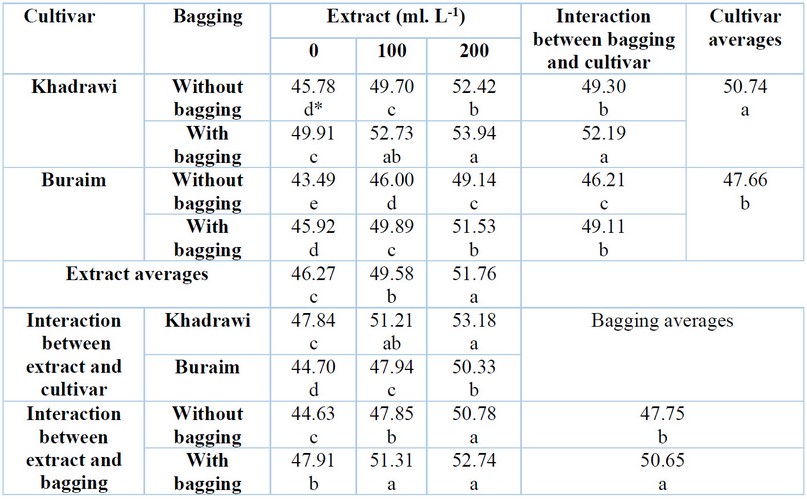
* Means that share the same letters do not differ significantly among
themselves according to Duncan’s polynomial test at the 0.05 probability level.
Table
5. Impact of applying moringa leaf extract, bagging the bunches, and their
interactions on Total sugars (%) of two palm cultivars.
Reducing sugars (%)
Table 6. shows that
the reduced sugar fraction was dramatically improved by application with moringa
leaf extract—the application that involved 200 ml. L-1 had the most significant proportion of reducing sugars, which came to
44.07%, while the comparison treatment had the lowest proportion, 37.44%. When
compared to the treatment without bagging, which came to 38.56%, the packaging
treatment obtained a proportion of 43.65%, a considerable improvement in the
proportion of reducing sugars. Regarding the cultivar component, Al-Khadrawi
surpassed the Al-Buraim cultivar with a considerable difference since their
respective reducing sugar proportions were 43.54 and 38.67%.
The outcomes of the
binary overlapping between extract application and bagging showed that the
combination of 200 ml. L-1 concentration and packaging produced the
most significant proportion of reducing sugars, 46.57%, while the comparison
treatment produced the lowest proportion, 34.75%—the two application treatments
with concentrations of 200- and 100 ml. L-1 was superior to the
Al-Khadrawi cultivar, where the reducing sugars in them reached 45.55% and
44.80%, respectively, but the comparison treatment on the Al-Buraim cultivar
recorded the lowest proportion, 34.60%. The combination of the cultivar and
bagging also contributed to the excellence of the packing treatment of the
Al-Khadrawi variety, which came in at 46.67%. In contrast, the Al-Buraim variety’s
treatment without bagging came in at the lowest proportion, at 36.70% (Table
6).In aspects of the triple interaction, the application of 200 ml. L-1
combined with the bagging of bunches of the Al-Khadrawi variety yielded the
most significant proportion of reducing sugars, amounting to 48.58%,
significantly outperformed the comparison treatments for the fruits of
Al-Buraim variety, which delivered the lowest proportion, 32.93%—table 6.
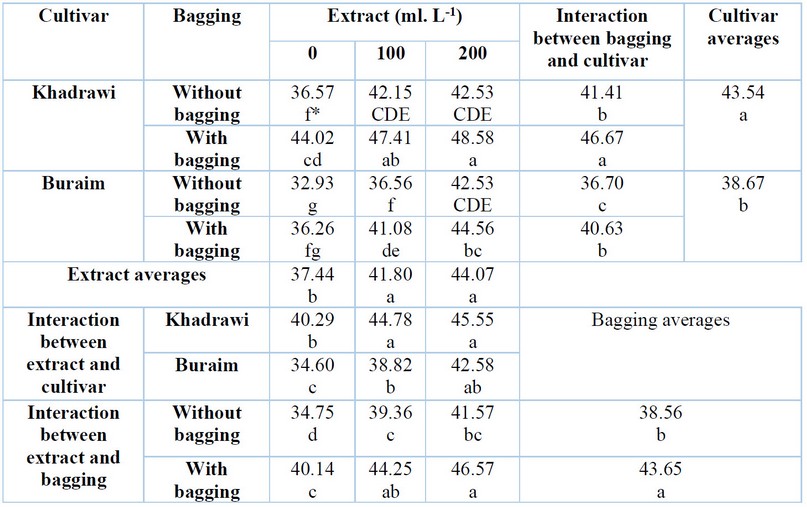
* Means that share the same letters do not differ significantly among
themselves according to Duncan’s polynomial test at the 0.05 probability level.
Table
6. Impact of applying moringa leaf extract, bagging the bunches, and their
interactions on Reducing sugars (%) of two palm cultivars.
Sucrose proportion (%)
Table 7
revealed that the sucrose rate decreased as the application concentration with
leaf extract increased. The control treatment (0 ml. L-1) recorded
the most significant proportion (8.87%), while the spray treatment with a
concentration of 200 ml. L-1 recorded the lowest proportion (6.77%). Fruit
packaging also reduced sucrose, as the proportion of sucrose in coated fruits
reached 6.97%, while the proportion in unwrapped fruits reached 8.65%. As for
the cultivar factor, the two cultivars differed significantly between them,
where the fruits of the Al-Buraim cultivar gave the most significant proportion
of 8.98%, while the Al-Khadrawi cultivar had a decrease in the proportion of
sucrose, which amounted to 6.64%. The binary interaction between the study
factors is shown in Table 7, which indicates that application with moringa leaf
extract at 0 ml. L-1 without bagging produced the most significant
proportion of sucrose, 9.97%, while the lowest proportion was 6.07% when
treating fruits with a concentration of 200 ml. L-1 with packaging.
The comparison treatment of the Al-Buraim cultivar was superior in the
bilateral interaction between application with the extract and the cultivar,
with a proportion of 10.11%, which did not differ significantly from the application
treatment with a concentration of 100 ml. L-1 on the same variety
amounted to 9.14%, while the lowest proportion of sucrose was recorded when applied
with 200 ml. L-1 for Al-Khadrawi cultivar, which amounted to 5.85%.
Regarding the interaction between the packaging and the cultivar, the Al-Buraim
cultivar benefited most from the treatment without bagging, where the proportion
of sucrose reached 9.48%, comparable to the 8.48% obtained through packaging
the same cultivar. Al-Khadrawi cultivar, however, got the lowest proportion,
5.45%, from its bagging treatment Table 7. The triple interaction between the
three factors was clear, where it was noted the superiority of the extract
spray treatment (0 ml. L-1) + without bagging for the fruits of the Al-Buraim cultivar, which
gave a sucrose proportion of 10.55%, while the lowest proportion recorded by
the spray application with 200 ml. L- 1 with the bagging of
Al-Khadrawi variety, which amounted to 5.15% Table 7.
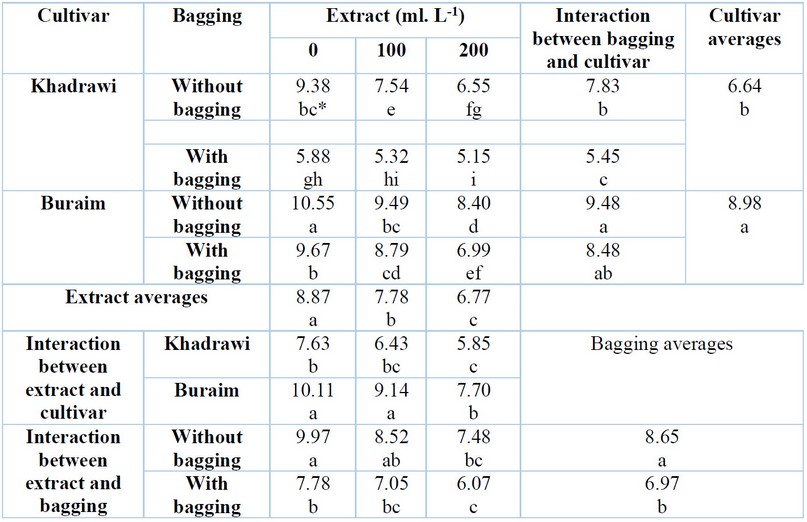
*Means that share the same letters do not
differ significantly among themselves according to Duncan’s polynomial test at
the 0.05 probability level.
Table 7. Impact of applying moringa
leaf extract, bagging the bunches, and their interactions on sucrose proportion
(%) of two palm cultivars.
Total Neutral Acidity (%)
The
findings of Table 8 show that the overall acidity was negatively correlated
with the rise in Moringa leaf extract concentration, with the control treatment
recording the most significant proportion of 0.95% and the 200 ml. L-1
spray treatment recorded the lowest proportion of 0.70%. The paper packaging
treatment reported 0.75% compared to the control treatment’s 0.86%, indicating
a reduction in acidity. The cultivars under study did not differ significantly
from one another. The interactive outcomes between application extract with
bagging showed that the control treatment was preferable; it recorded the most
significant proportion (1.02%) during the application with 200 ml. L-1
with bagging recorded the lowest proportion, 0.67%—the application treatment
with a concentration of 200 ml. L-1 on the Al-Khadrawi cultivar
recorded the lowest proportion, 0.69%.
In
contrast, the comparative treatment for the cultivar Al-Buraim was
significantly better than the other treatments due to the interaction between
the application of extract and the cultivar, where a proportion of 1.02% was
recorded. The interaction treatment between bagging and cultivar did not show
significant differences for the Al-Buraim cultivar, while the bagging treatment
impacted significantly on the Al-Khadrawi cultivar, where the unwrapped bunches
gave this cultivar the most significant acidity proportion of 0.85%. In
contrast, the bagging reduced the acidity of the same variety, which amounted
to 0.73% Table 8.
Findings from the triple impact in Table 8 revealed
that the control application of the Al-Buraim cultivar was significantly
superior in recording the most excellent acidity of 1.10%, while the
application of 200 ml. L-1 with bagging on Al-Khadrawi cultivar
recorded the lowest proportion of 0.67% Table 7.
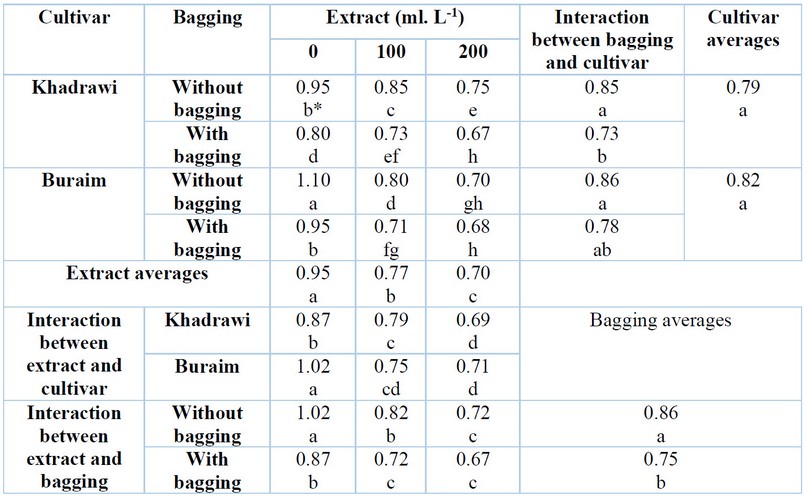
*Means that share the same letters do not differ significantly among
themselves according to Duncan’s polynomial test at the 0.05 probability level.
Table
8. Impact of applying moringa leaf extract, bagging the bunches, and their
interactions on total neutral acidity (%) of two palm cultivars.
The proportion of tannins in the
fruits (%)
The data
in Table 9 indicate that application with Moringa
leaf extract and bagging significantly reduced the proportion of tannins in the
dates. The application is 200 ml. L-1 recorded the lowest proportion
of 0.35 compared with the most significant rate of 0.46% with the control
treatment, while the treatment of fruit packaging recorded 0.35 % compared with
the unwrapped fruits, which recorded 0.46%. As for the cultivar factor, the two
cultivars differed in the proportion of tannins. The most significant
proportion was in the Al-Khadrawi cultivar. Its fruits contained 0.43%, while
the Al-Buraim fruits contained 0.39% g.
The dual
interactions in the same table indicate the superiority of the treatment of 200
ml. L-1 with the packaging recorded the lowest proportion of 0.33,
while the most significant proportion recorded by the comparison treatment was
0.53%, and the application with 200 ml. L-1forAl-Buraim variety
showed a significant decrease in the proportion of tannins that amounted to
0.35, While it increased in the comparison treatment for the Al-Khadrawi
variety to 0.48%. As for the interaction between the bagging and the cultivar,
the unbagged bunches of the Al-Khadrawi cultivar boosted the proportion of
tannins in its fruits, which gave 0.48%, while the practice of the Al-Buraim
cultivar recorded the lowest proportion, which amounted to 0.34% (Table 9).
Concerning
the triple interactions between the experimental factors, the comparison
treatments for the Al-Khadrawi cultivar recorded the most significant
proportion of tannins, which amounted to 0.54%. In contrast, the application
treatment had a concentration of 200 ml. L-1, coupled with the
packaging on the Al-Buraim cultivar, recorded the
lowest proportion, which amounted to 0.33% (Table 9).
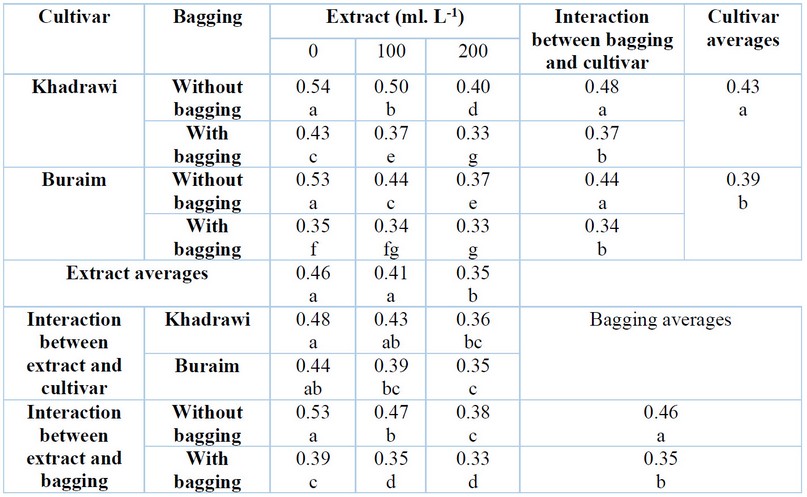
* Means that share the same letters do not differ significantly among
themselves according to Duncan’s polynomial test at the 0.05 probability level
Table
9. Impact of applying moringa leaf extract, bagging the bunches, and their
interactions on the proportion of tannins in the fruits (%) of two palm
cultivars.
.
DISCUSSION
The outcomes of the previous tables
demonstrate that the use of moringa leaf extract significantly enhances data
quality(boosting T.S.S., total and reducing sugars, decreasing sucrose, and
tannins), perhaps because the extract contains several hormones, especially
auxins, which play a role in luring compounds produced by photosynthesis to be
stored in fruits and enhance their quality 20 or
maybe that the total sugars increased in the dates as a result of the
early ripening of the fruits, which led to an enhancement in sugar and thus the
proportion of soluble solids in the fruits increased Additionally, it
stimulates several cytoplasmic enzymes that convert organic acids into sugars,
reducing the acidity of fruits and boosting their sugar content. The calcium
and potassium in the extract, which play a crucial and necessary function in
development by regulating and activating enzymes 22, may also cause
an increase in sweetness and softness of the fruits. These findings concur with23,
who found that application of salami palm bunches with a concentration of 6%
Moringa leaf extract resulted in the most significant proportion of total
soluble solids, the greatest proportion of total and reducing sugars, and the
lowest acidity when compared to the control treatment. This is also in line
with 24, which discovered that applying the extract on seedless grapes boosted
the total soluble solids and sugar proportion while lowering the neutralizing
acidity. The outcomes also demonstrated that the fruit bagging procedure
enhanced the quality of the fruits by creating an environment favorable for
fruit development by increasing the humidity around the fruits, which resulted
in the creation of an environment favorable for enzyme activity or by playing a
role in the prevention of photo-oxidation of internal hormones25.
These findings are in line with those made by13, who found that the brown paper bagging
process on the Halawi and Sayer cultivars affected the majority of the fruit’s
constituent parts as the proportion of total soluble solids, total and reducing
sugars, and the fruit’s moisture content increased. Additionally, the findings
of this study concur with those of 14 who found that the chemical
characteristics of the fruits of the Khastawi cultivar were enhanced by bagging
them in various cover materials. Naturally, the difference between the two
cultivars in the studied characteristics is due to the genotype controlling the
phenotypic characteristics of the fruits.
The results of this study indicate
that it is possible to rely on natural extracts, such as those from Moringa
leaves, to enhance the quality characteristics of the fruits because their use
increases the proportion of total and reducing sugars as well as total soluble
solids while decreasing the proportion of sucrose and neutral acidity. Paper bagging
can also be advised as an agricultural approach to improve some of the
qualities of fruits and create an appropriate environment for their development
and ripening. In addition to the research elements’ substantial impacts,
utilizing these treatments in combination is desirable since their interactions
produced fruits of excellent quality. This research also suggests investigating
the effects of other components of this miraculous tree, including its fruits,
seeds, and roots, on the development and quality of other horticultural crops,
either on their own or in combination with other agricultural techniques.
Author
Contributions: Mohammed
Abdulrahman; Field application of treatments, Data collection, resources, writing
and drafting. Manar Alwan: Supervision, guidance and follow-up, review, and
editing. Kadum Abdullah: Supervision, guidance and
follow-up, review, and editing.
Funding: External
support money was not used for this study.
Data
Availability Statement: All data is available
by the first author.
Acknowledgments: I
extend my thanks and gratitude to the management of Fadak farm the Department of Horticulture
and Landscaping, and all those who helped in the completion of this research
Data
Availability Statement: All data is available by the first author
Conflicts
of Interest: The authors declare no conflict of
interest.
1.
Jassim, N. S.;
Saleh, A. D. Efficiency of using Bacillus subtilis as a growth regulator
and its effect on the phenotypic and physiological characteristics of date palm
offshoots Phoenix dactylifera L. under salt stress conditions. Journal
of Kerbala for Agricultural Sciences,2018. Volume 5, Issue 4,
pp. 1-5.
2.
Al-Hamdani,K.
A. S.; Muhammad, M. H.; Hussein, M. N. Date Palm, first edition. Tikrit
University Press,Iraq, 2022.pp340.
3.
Idowu, A. T.;
Igiehon, O. O.; Adekoya, A. E. ; Idowu, S. Dates palm fruits: A review of their
nutritional components, bioactivities and functional food applications. AIMS
Agriculture and Food,2020. 5(4), 734-755.
4.
Al-Aqidi H. K. The
date palm is the lady of the trees and the fruit of the fruit. first
edition. the Hashemite Kingdom of Jordan,2010. p 396.
5.
Hussein, P. A.
Description of some varieties of Iraqi date palms. The National Committee for
the Registration and Approval of Agricultural Varieties. The national program
for the propagation, improvement and cultivation of date palms. Ministry Of Agriculture.
The Republic of Iraq ,2002.
6.
Ali, A. A.;Falih,
S. A.;Idan, R. O.; Aziz, H. M. Response of seedlings of olive cultivar Khudairi
to treatment with licorice and yeast extracts., Journal of Kerbala for
Agricultural Sciences,2017.Volume 4, Issue 4, pp. 56-68.
7.
Godlewska, K.;
Ronga, D.; Michalak, Izabela. Plant
extracts-importance in sustainable agriculture. Italian Journal of Agronomy,
2021, 16.2.
8.
Ertani A.;PizzeghelloD.
;Francioso O;Tinti A. ;Nardi S. Biological activity of vegetal extracts
containing phenols on plant metabolism. Molecules,2016,21:1-14.
9.
A.L.- Shamary,
W. A. .; Alkhateb, B. A. A. H. .; Abdel, E. T. . Role Of Perlite Quantity And
Intervals Of Irrigation On Potatoes (Solanum Tuberosum L.) Grown In Gypsiferous
Soil. Journal of Life Science and Applied Research. 2020, 1, 31-39.
10.
Abdalla, M. M.
The potential of Moringa oleifera extract as a biostimulant in enhancing
the growth, biochemical and hormonal contents in rocket (Eruca vesicaria subsp.
sativa) plants. Int. J. Plant Physiol. Biochem,2013,Volume 5(3):
42-49
11.
Mahmood, N. A.
& Abdulateef, S. M. Determining Some Undesirable Behavioral Traits and
Their Impact on the Behavioral Performance of Broiler Chicks. in I.O.P.
Conference Series: Earth and Environmental Science .2021,vol. 904.
12.
Mustafa, A.;
Abdel-Hamid, N.; Abd El-Hamid, A.; El-Sonbaty, M.; Abd El-Naby, S. Improving
Fruit Set, Yield and Fruit Quality of Khadrawi Date Palm Cultivar. Arab
Universities Journal of Agricultural Sciences,2018. Volume 26(4),
1461–1470.
13.
Sharif, H. J.
Effect of bagging and licorice extract on early ripening and improvement of
fruit characteristics of date palm Phoenix dactylifera L. Al-Sayer and
Al-Hallawi cultivars,Master Thesis, University of Basra, College of
Agriculture, Horticulture and Palm Department. Iraqi-date palms.net.2008.
14.
Al-Issawi, M.
Evaluation of the efficiency of the date and type of taste mastication in the
qualitative characteristics and degree of maturity of date palm fruits of the
Khastawy cultivar. Master’s thesis, College of Agriculture, University of
Anbar, Iraq.2020.
15.
Al-Rawi, K. M.;
Muhammad, K. A. Design and analysis of agricultural experiments, second
edition. University of Mosul, Ministry of Higher Education and Scientific
Research. Republic of Iraq.2020.
16.
Noaman A I,
Khalaf R M, Emad GH, Al-Abbasy, Mohammed Th. T. Effect of flaxseed oil dosing
on fertility, growth characteristics and some physical, biochemical, and
hormonal blood parameters during the early pregnancy of Awassi ewes. Revis
Bionatura. 2022;7(4) 5. http://dx.doi.org/10.21931/RB/2022.07.04.5.
17.
A.O.A.C.
Official Method of Analysis. Association of Official Method of Analytical
Chemists Washington. D.C.,1970. p 910.
18.
Howrtiz , W.
Official methods of analysis association of official analytical chemists Washington, D.C. 1975 . 221p.
19.
Ali, H.H.,
AL-Rawi, K., Khalaf, Y., Alaaraji, S., Aldahham, B., Awad, M., Al-ani, O.,
Al-ani, F., Ali, A.T.Serum Caveolin-1 Level is Inversely Associated with Serum
Vaspin, Visfatin, and HbA1c in Newly Diagnosed Men with Type-2 Diabetes.Reports
of Biochemistry and Molecular Biology,2022, 11 (2), pp. 299-309.
20.
H. Muhammed,
S., Y. Mohamed, R. Investigation And Molecular Identification Of Cucumber
Damping-Off Fungi Under Greenhouse Condition. Anbar Journal Of Agricultural
Sciences, 2023; 21(1): 19-31. doi: 10.32649/ajas.2023.179712.
21.
Al-Hamoud, F.
Some of the physical, chemical and physiological characteristics of the fruits
of the fruit. (2019). Master Thesis, College of Agriculture, University of
Basra, Iraq.
22.
Hasegawa, P.M.;Bressan,
R. A.; Zhu, J. K.;Bohnert, H. J. Plant cellular and molecular responses to high
salinity.Annu Rev Plant Physiol,2000.Volume51: 463-499.
23.
Thabet, A. Y. I.;
Abdel-Hak, R. E. S.; Ashour, N. N.; Hassan, H. S. Influence of foliar
application with moringa (Moringa oleifera L.) aqueous leaf extract on
fruit set, yield and fruit quality of Selmy date palms. Egyptian Journal of
Chemistry,2022. Volume 65 (9), 1-2.
24.
Aly, M. A.; Harhash,
M.M.; Bassiony, S. S.; Felifal, M.M. S. Effect of Foliar Spray of Sitofex,
Moringa Leaves Extract and Some Nutrients on Productivity and Fruit Quality of
“Thompson seedless” Grapevine. Journal of the Advances in Agricultural
Researches,2020. Volume 25(1):112-129.
25.
Mohammad, A. A.;
Al-Rayes, A. H. Plant physiology. The second part. Ministry of Higher Education
and Scientific Research,. College of Agriculture, University of Baghdad, Iraq.
1995.
Received: 26
September 2023 / Accepted: 15 April 2023 / Published:15 December 2023
Citation: Abdulrahman,M.; Alwan, M.; Abdullah,
K. Chaffat, M. The performance of moringa leaf extract application
and bagging the bunches to improve fruits quality of date palm (Phoenix
dactylifera L.) cv. Al-Khadrawi
and Al-Buraim. Revis
Bionatura 2023;8 (4) 86. http://dx.doi.org/10.21931/RB/2023.08.04.86
Publisher’s Note:
Bionatura stays neutral with regard to jurisdictional claims in published maps
and institutional affiliations.
